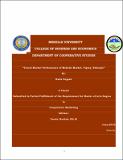| dc.description.abstract | The general objective of the study is to evaluate the performance of cereal market and the
specific objectives are: to analyze the current status of cereal markets, to identify constraints of
the cereal market, to analyze the integration of markets around Mekelle, and to analyze the role
of cooperative societies in Tigray in the out put market. The populations of the respondents are
50 traders, 50 consumers and 100 farmers and 25 experts that is, total of 225. The method of
sampling is simple random sampling for traders and systematic sampling method for consumers
and farmers. This is because there is no list of consumers and farmers coming to the market
inaddition the list of the farmers in each tabia is huge that makes the simple random sampling
more difficult, so as a solution the systematic random sampling method is chosen. The
performance of the cereal market using concentration ratio has shown that the cereal market is
competitive that is the market share of the 4 largest traders is 22.31%, 19.12%, 20.3%, 16.73%,
and 13.9% for wheat, tef, sorghum, others and all cereals respectively. In addition the research
finds that most markets around Mekelle are integrated and the total gross marketing margin is
computed to be 8.7% and 9 % for wheat and barley, respectively. This shows that the farmers’
share is high that is 91.3% for wheat and 91% for barley and even it is more than that if it is
calculated taking the farmer retailers’ price that is about 93.37% and 93% for wheat and
barley, respectively. The identified cereal market problems are: infrastructure problem followed
by price related problems, supply problems, lack of proper contract agreement and
enforcements and lack of real and timely information, and demand shortage. The
recommendations given are: Expand and strengthen the already started market information
system of the region, that is, weakly dissemination of price information through the local radio
and notice board and the biweekly publishing magazine of market information. Increase the
knowledge of farmers and traders through adult education programs and extension services
especially that of marketing related extension services. Cooperatives together with government
participation in the market can be solutions to the long marketing chain, market failure, to
eliminate mal practices, to add value, to reduce costs, to increase satisfaction and generally to
improve the market and marketing systems. Financial constraint is still problem of farmers, so
needs to strength the saving and credit cooperatives to handle the problem, which will have dual
advantage that is solving the capital shortage and reduce food insecurity. Therefore,
cooperatives should be given enough technical and financial support . | en_GB |


